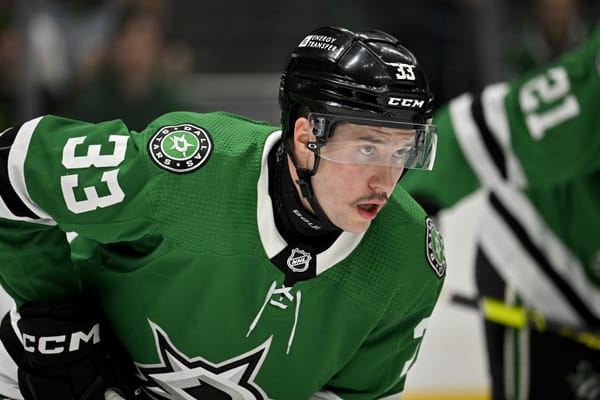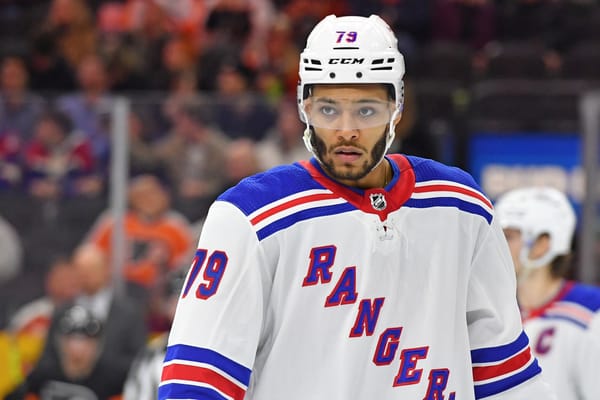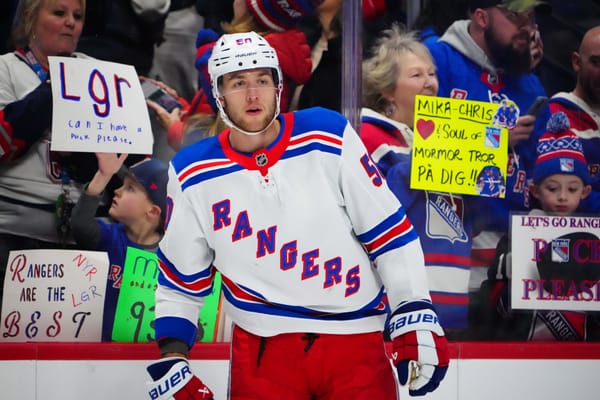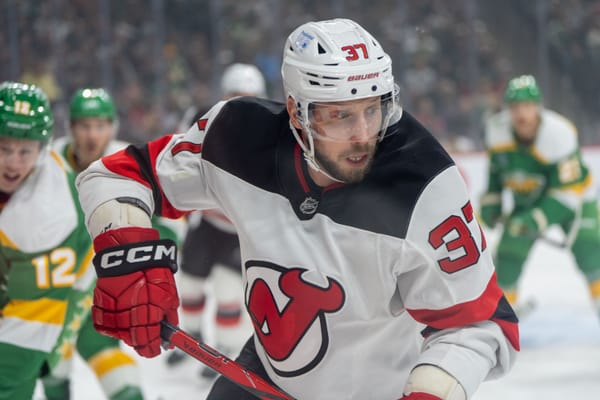The Complications of Jimmy Vesey
It’s been just three games but Jimmy Vesey has found himself at the center of a fair amount of discussion so far.
Before the regular season opener on 10/4, I discussed how Vesey’s struggles really couldn’t keep him out of a top-six role because of the complications moving him down creates. From that article:
That night, Vesey did, well, Vesey things against Nashville. He was one of the most noticeable players on the ice, but couldn’t finish. Something I referenced in my notes story on the game the next day:
He was easily the most noticeable forward through the first 30 minutes, was all over the ice, and generated/was on the end of about three Grade A chances. That was the good. The bad was that he didn’t finish any of them. Is this a harsh take? 100%. But here’s the thing: Vesey needs to score because the other side of his game isn’t good enough. And that is especially true if he’s going to be on the second line. When I made this point on Twitter a lot of people replied with “if he plays like that every night he’ll score 30 goals.” And that is a correct. The problem with Vesey, though, is that those games are far and few between. Let’s hope that changes.
While noticeable in all three games, he didn’t find his finish until he scored two against Carolina. Complicated takes like the one I gave above continue to surface when it comes to Vesey: the good and the bad often come together.
Over the three-game span, Vesey has a 5v5 corsi of just over 45%. While obviously not ideal (or out of the ordinary for him), it’s only -0.68 relative to the team average, so he’s only slightly behind everyone else. On the flip side, at 5v5 Vesey has been on the ice for two goals for (both of his, obviously) and four goals against. His expected goals percentage is 49.6% which is actually +1.3% compared to the rest of the team. See how weird this gets?
Before you get into the “small sample size” argument, this three-game snapshot from Vesey is remarkably close to what he’s been in his career. Here’s this three-game span compared to his career averages:
He’s pretty much been, in these three games, what he’s been in his two full seasons. Which is fine! But again, the consensus seems to be that these three games of Vesey has been “new Vesey” where Quinn has started to uncover that next gear. The reality is we’re just seeing him more, but nothing else has really changed.
For most players the above would paint you a picture of a depth player who would need to provide some value to keep them in the higher end of the lineup. For Vesey that value is in scoring a fair amount of goals, which warps the perception about what he is as a player because goals are gold in this business. In his rookie year he scored 16 goals; in his sophomore year he scored 17. On the surface that’s fine, right? Yes! But as always there’s a flip side: Vesey has never once acceded past 28 points as an NHLer, and it’s hard to imagine a guy like Vinni Lettieri couldn’t provide the same things Vesey does at a lesser cost. It’s also not hard to realize that a guy like Jesper Fast is actually what people think Vesey is, with all the defense that you don’t get on the other side of the ice.
It’s worth noting that “goal scoring winger” Vesey is different than a prototypical scorer. On Ep. 111 of the podcast Mike and I dissected how Vesey’s particular talents at scoring — dirty goals around the net/banging home rebounds — complicates things further. The perception when he started the year with Mats Zuccarello was, “fantastic, Zuccarello can feed him all night.” But again, Vesey doesn’t generally get to open areas and wait for passes, he cleans up around the net. With Zuccarello’s lack of a shooting mindset, and Hayes being the puck-lugger on that line, the two don’t mesh as well as they would with, say, Lettieri — who is a volume shooter — or even a Chris Kreider or Pavel Buchnevich.
That’s not to say Vesey won’t succeed there — there’s plenty of mess around the net to clean up with Hayes, and Zuccarello is still a wizard after all — but just that sometimes the puzzle pieces don’t fit exactly how you would expect them to.
I have often said — and still maintain — that I like Vesey a lot as a depth player. Guys like Vesey often score one or two enormous playoff goals, or help you win a few games with out-of-the-blue explosions. They’re valuable. All that said, Vesey really isn’t a top-six player, and probably won’t be. I know there’s an ideology that David Quinn will connect to him on a different level because both came to the NHL from the college ranks, but at 25 there probably isn’t another level to his game to be unlocked. I could, of course, be wrong about that — especially based off how noticeable he was in the past three games.
It's no secret that I've not been a Jimmy Vesey fan, but if this is the player he's becoming, I'm about to turn on a dime.
— One Sport Guy, Phil (@PhilKocher) October 7, 2018
Even so, it’s not all that difficult to find four wingers more deserving of a top-six spot. Kreider, Buchnevich, and Zuccarello are already there, but Ryan Spooner, Vladislav Namestnikov (depending on whether or not he can come out of this mild tailspin), and even Fast are more valuable options there. (Fast, by the way, leads the team with three points.)
Based on Tuesday’s practice lines, Vesey is being demoted to what I’m considering the third line. With the jumble below, though, it’s hard to tell what is the second and third groups.
Everybody in the pool here at #NYR practice (no specific order): Vesey-Hayes-Spooner, Buchnevich-Zibanejad-Fast, Kreider-Howden-Zuccarello, Namestnikov-Chytil-Lettieri.
— Brett Cyrgalis (@BrettCyrgalis) October 9, 2018
Skjei-McQuaid, Smith-Pionk, Staal-DeAngelo, Claesson-Shattenkirk (gulp).
So here we are, three games into Vesey’s third season with the team and just as little of an idea of where the future is as on day one.
Like I said at the top: It is complicated.





